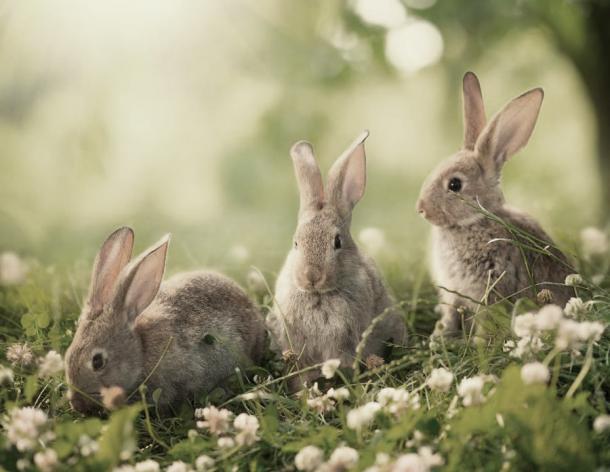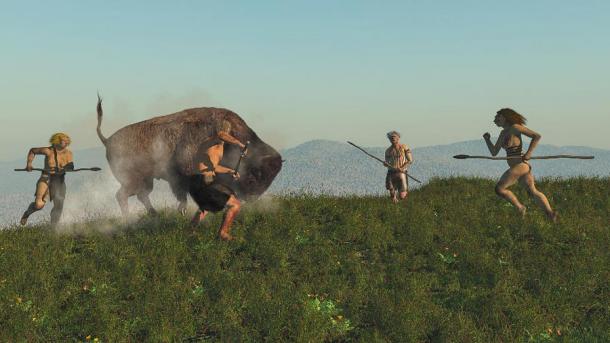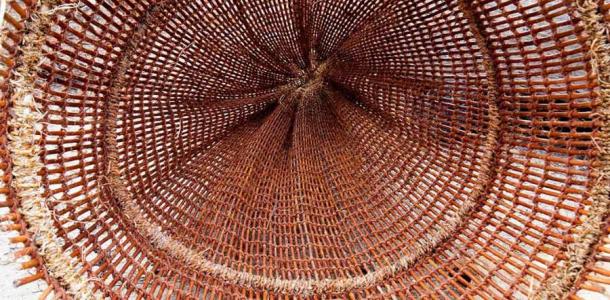How Rabbits Led to Neanderthal Extinction in Iberia and Elsewhere
There were undoubtedly many reasons why the Neanderthals finally went extinct in Europe 40,000 years ago. One hypothesis states that the inability of the species to adapt to hunting small animals when large mammals decreased in numbers played a big role in their ultimate demise.
This theory was explained in a landmark 2013 study that was published in the peer-reviewed Journal of Human Evolution.
This particular study, which was carried out by a team of scientists from universities in Spain and the United Kingdom, focused on the extinction of Neanderthals on the Iberian Peninsula. The scientists concluded that Neanderthals were doomed in Iberia because they were unable to successfully hunt rabbits, the prey species that was most widely available in that region 40,000 years in the past. This was in contrast to modern humans, who migrated to the Iberian Peninsula 42,000 to 45,000 years ago and quickly adapted to what the land could provide.

The rabbits came to prehistoric Iberia or modern-day Spain, and this led to Neanderthal extinction because they were not so good a trapping or catching smaller prey! (Subbotina Anna / Adobe Stock)
Elusive Rabbit Prey Led to Neanderthal Extinction In Iberia
Between 160,000 and 40,000 years ago, Neanderthals who belonged to the Mousterian culture lived on the Iberian Peninsula, which is comprised of modern-day Spain, Portugal, and southern France. For most of that period they got all the animal protein they needed to survive from hunting larger animal species like mammoths and rhinoceros.
In the latter part of that period, however, populations of large game animals in Iberia began to decline significantly. This may have been caused by changes in the climate, or from overhunting that occurred when humans migrated to Iberia and joined the Neanderthals in hunting those species. Conversely, rabbit populations soared during this same time period.
- All About Neanderthals – The Surprising Facts
- Did light-skinned, redheaded Neanderthal women hunt with the men?
“High dependence on the hunting and consumption of large mammals by some hominins may have limited their survival once their preferred quarry became scarce or disappeared,” the study authors wrote in their Journal of Human Evolution article. “Adaptation to smaller residual prey would have been essential after the many large-bodied species decreased in numbers.”
For Mousterian Neanderthals, that should have meant an increasing focus on hunting rabbits.
“Unlike the Italian Peninsula and other parts of Europe, in Iberia the rabbit has provided a food resource of great importance for predators including hominins,” the scientists explained.
Human hunter-gatherer groups were able to make such an adjustment. This is shown by studies of animal bone deposits taken from archaeological sites in caves in Spain and southern France, which showed that Homo sapiens were killing and eating rabbits in ever increasing numbers between 40,000 and 30,000 years ago.
But animal bone deposits found at ancient Neanderthal sites on the Iberian Peninsula told a different story. While rabbit hunting wasn’t unheard of among Iberian Neanderthals, it was apparently too rare for rabbit meat to meet a substantial percentage of the Neanderthals’ daily caloric needs. The problem became especially acute right around the time Neanderthals disappeared from the Iberian Peninsula for good, during that 30,000 to 40,000 years ago time frame.
“We suggest that hunters that could shift focus to rabbits and other smaller residual fauna, once larger-bodied species decreased in numbers, would have been able to persist,” the scientists wrote in their Journal of Human Evolution article.
The implication of this statement is that those who were unable to adapt—like the Mousterian Neanderthal hunter-gatherers—would not have survived in the long run.

According to a remarkable 2013 research study, Neanderthals excelled at bringing down large prey with advanced spears, but when the big animals were gone they were unable to adapt their hunting methods for smaller animals and thus went extinct. (nicolasprimola / Adobe Stock)
Why Neanderthals Living Everywhere Were Ultimately Doomed
If it is indeed true that Neanderthals in Iberia suffered and ultimately died out because they didn’t kill and eat enough rabbits, it raises an obvious question: Why they didn’t adjust their hunting habits to take advantage of what was available?
The researchers involved in the 2013 study believe the problem lay not with an unwillingness to hunt rabbits, but an inability to do so.
Neanderthal hunters 50,000 years ago relied on spears to hunt large mammals. These animals made large targets, which made it easier to kill them with long, sharpened sticks that could either be thrown at them with force or thrust into them at close range.
Unfortunately for the Neanderthals, this methodology wouldn’t have worked with rabbits. They were too small, quick, and elusive. It wouldn’t seem that this was an insurmountable problem, but the archaeological record indicates that Neanderthals living in Iberia never did have much luck hunting rabbits. While humans who lived in Iberia 30,000 to 40,000 years ago were able to smoothly transition to hunting rabbits when other sources of animal protein disappeared, for whatever reason it seems the Iberian Neanderthals couldn’t do the same.
"I think modern humans had more technologies to catch these fast-moving smaller prey items, like nets or traps,” study co-author John Stewart, a professor of Evolutionary Paleoecology at Bournemouth University, told the BBC in 2020. “Certainly when times got tough modern humans always had more at their disposal."

Nets and traps for catching small animals was something Neanderthals weren’t very good at but Homo sapiens, on the other hand, figured this out and survived. (EXARC)
This suggests that in at least this one area, Neanderthals lacked the ability to adapt to changing environmental circumstances as efficiently as humans. This implies a difference in intelligence, and it also suggests that modern humans and Neanderthals living in Iberia at the same time weren’t sharing secrets or trading technologies (otherwise the Neanderthals could have learned how to hunt rabbits by watching or learning from their human neighbors).
A lack of success hunting rabbits for food may have been the problem in Iberia. But John Stewart believes their struggles in this regard revealed a more generalized limitation in Neanderthal adaptability.
“I think the rabbit was just a symptom [of their extinction] rather than the cause,” Stewart said. “Neanderthals were more vulnerable because they had less tricks up their sleeve, less breadth of possibilities.”
In other words, wherever Neanderthals were living the disappearance of large land mammals would have put them it a difficult position. Smaller prey of all types might have been around, but they wouldn’t have known how to exploit those resources for food to a sufficient degree to guarantee their survival.
- Neanderthal Alchemists Enhanced Weapons 70,000 Years-Ago
- Adapt, Diversify, Find a Niche: Survival Tactics of Homo Sapiens That Brought World Domination
This wouldn’t have been the only reason why they ultimately died out. A 2019 study revealed that fertility declined among Neanderthals in the latter stages of their existence. This could have been influenced by a lack of food and the bad health that caused, and by greater levels of inbreeding as Neanderthal populations decreased.
Abrupt shifts in climate from cold to hot and back again put more strain on the Neanderthals over the last 50,000 years or so of their existence, as they struggled to feed themselves in the harsher conditions brought on by these changes.
As a result of these multiple factors, one by one the various Neanderthal groups living in different areas vanished from the face of the earth. Fortunately, they left behind bones and artifacts that archaeologists and historians could use to reconstruct their fascinating history, ensuring that their existence would not be overlooked.
Top image: Researchers over the last decade have narrowed in on the cause of Neanderthal extinction in prehistoric Spain and the answer is that they were unable to trap or capture smaller prey, especially rabbits. Source: Akkharat J. / Adobe Stock
By Nathan Falde


















Comments
We Homo Sapiens have the ability to put a spin on a spear because of our wrist bones. Like with a football (American football). So our ancestors could throw a smaller spear farther and more accurately. Neanderthals did not have that ability with their wrists. So their spears could only be used for thrusting and stabbing. They could not adapt. It was not a choice.
Evolution is not what many people think it is. It is simply the ability to adapt and change. Neanderthal could not, but we could.
Phil
Anyone who’s watced ALONE knows you can’t survive on RABBITS!!! The assertion that Neaderthal could not adapt is beyond ridiculous. Those people had no choice but to live there and died out because they couldn’t leave: why? Lets ask that question!
KiminNehalem
They may be scientists, but not nutritionists! Rabbits aren't that good a food animal, and any diet involving rabbits has to include a lot of other things because rabbit is deficient in important vitamins and minerals. I would've thought wild pig would've been the prey animal of choice, they're pretty common in the Mediterranean to this day!
When the square peg doesn't fit in the round hole, the Neanderthal just die? Get a grip. No one can survive on rabbit alone. The just don't have enough fat. A plandemic is more plausible than this.LOL. Awesome picture of a blue eyed brute scarfing a raw rabbit though.
...besides, is it possible to eat every rabbit in Iberia? I don't believe they did "die out" they assimilated. I chunk of my DNA says so.
Pages